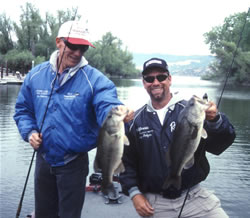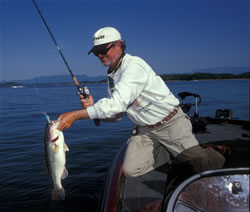|
||
|
|
How To Pattern BassA Bass Is A Bass Is A BassBy Margie Anderson
Apparently they assume that EVERYONE on the water is smarter than they are. There are some who spend hours on the phone, pumping their buddies for information and trying to duplicate their results. And then there are the pros. The real pros know that you have to find your own fish. It’s really hard to catch someone else’s fish, insists Gary Dobyns. If you weren’t there to find them and figure out what it took to catch them, it’s almost impossible for someone else to send you to that spot and have you catch fish. A pro like Dobyns, who is able to find and catch bass consistently, has learned the secrets to patterning bass. It doesn’t matter what state or even what country you are in, says legendary bass pro Rick Clunn, a bass is a bass is a bass no matter where he lives. Bass are animals with certain needs and instincts. They all respond alike to biological stimulus. This is certainly to the advantage of a bass fisherman; learn how bass behave under certain conditions, and you’ll know where to look for them. Rick Clunn has proved it by winning bass tournaments from one end of the country to the other, in canyon reservoirs, natural lakes and rivers alike. The first and most important thing Clunn does when he gets on the water is turn off the background noise. In other words, he starts to think fishing. He focuses his mind to visualize catching fish and keeps a positive attitude. Clunn is probably better than most at “getting into the zone.” This is that magic place that you find yourself when you can’t seem to do anything wrong. It’s where you know just where to cast and almost know exactly when and where a fish will bite. When you’re in the zone, nothing disturbs your total concentration on fishing. Clunn has a three-step process he uses to pattern bass — first: seasonal pattern; second: current pattern, and third: specific pattern. Clunn says only 10 to 15 percent of anglers will ever get to the point where they can get to the third step. More on that later. Seasonal Patterns
Clunn also divides individual coves into the same three types of sections, adding a fourth section for a river or navigable creek. A seasonal pattern does two main things for you, Clunn says — it eliminates non-productive water, and puts you in the places where you’ll get the most bites. To determine which section to fish, Clunn relies on past experience, his notes and records, and published tournament results. He’s interested in what part of the lake produced winning stringers in the past — not so he can go to the same exact spot, but so that he’ll know what types of areas on which to concentrate. He takes care not to mix unlike bodies of water in his notes and bases his choices on time of year, water temperature, and conditions. Current Pattern Ask yourself this, says Clunn: In the area you are fishing right now, what are the fish doing? Once you’ve decided on a seasonal pattern and chosen a section to fish, fish that area as though it were a pond, Clunn advises. First, identify all the visible objects in the water. Bass are really object-oriented fish, and 98 percent will be relating to some kind of object, he says. Once you’ve identified the types of objects in the area, fish each of them thoroughly. Say you’ve located a stump field, floating vegetation, submerged grass, a small channel, and some sunken brush in a cove. Work each and every kind of object until you get the feeling that you’ve really probed it efficiently. Eventually it will become clear to you which types of objects are holding the fish. Now you have a set of sub-patterns to figure out, says Clunn. There are two types of current patterns: individual fish or concentration patterns. Say you throw a Senko by a big stump and find two fish. That’s an individual pattern, and to replicate it you’ll have to keep moving and finding similar stumps in similar depths. This kind of fishing is sometimes called a “milk run.” It just means you keep going from spot to spot all day long. Clunn emphasizes that once you’ve discovered this current pattern, ignore all the stuff in between. If the fish are on stumps that day, you’re wasting time throwing worms in the grass, he says. A concentration pattern is usually something like a mass of flooded brush or vegetation that is holding an entire school of bass. These are not individual objects; they are masses of objects. When you find a concentration of fish, says Clunn, stay there! The individual pattern is the most common type of current pattern, Clunn says. The key to success once you’ve pinpointed this pattern is to go from one individual object to the next as quickly as possible without wasting time fishing between them. If you’ve found big fish on lay-down logs half-way back in the coves, just run from cove to cove and fish only those lay-down logs that are in the right position. DON’T FISH BETWEEN PATTERNS. A pattern can last three days or three minutes, Clunn says. If the pattern fails, start over and figure out what the NEW current pattern is. Specific Pattern: Elite Fishermen Step three is something few anglers do consciously, Clunn states. An elite fisherman will simply perform step three without even thinking about it or even realizing that he is doing it. Here’s an example: A whole salt cedar is a current pattern. You’ve fished every type of object in your area thoroughly, and you’ve established that the bass are in the salt cedars. So, you start moving from one salt cedar to the next, skipping all the stuff in between. An elite angler will establish an even more specific pattern; he will realize exactly WHERE in the salt cedars the fish are. He’ll start fishing just that part of the salt cedar before moving on. A salt cedar is a current pattern. A branch on the salt cedar is a specific pattern. The first fish you catch will tell you where they are, says Clunn. Listen to the fish. In other words, if your first fish takes the bait on the fall, don’t waste time fishing on the bottom. Awareness is crucial to a good fisherman. Clunn says you have to exercise mental awareness just like you do your physical attributes. Lure Selection For Establishing A Pattern Your most important fishing asset is your head, says Clunn, not your tackle. Your tackle is just tools to complement your abilities. The only valid reason for selecting a bait is confidence. The most important function of a lure, says Clunn, is NOT to catch fish; it’s to FIND them. Clunn’s top three lures to find fish in all seasons and all conditions are spinnerbaits, crankbaits, and plastic worms or jigs. He normally chooses a spinnerbait or crankbait to begin. “I ask myself what lure I can work that area with quickly but thoroughly,” he says. “The most efficient speed is an individual thing. Choose a bait that will keep you close to objects [in the strike zone] the most time.” Deflection, or bouncing the lure off objects, is the #1 generator of strikes, Clunn says. It’s survival of the fittest down there and the bass prey on the weak. And weak prey is erratic. As for color, Clunn says that he thinks fishermen think about lure color more than they think about sex. “Your confidence in your fishing is totally in control of your success,” he says. “You’ve got to BELIEVE that you will catch fish. “So pick any color you want as long as you believe in it.” He himself likes clear, natural colors, shad, and crawdad colors. “If you don’t feel good about a color,” he insists, “you won’t fish it right.” Sudden Changes What if you pre-fish the day before a tournament and you’re really on ‘em. You know exactly what objects they are using and where those objects are. Then a cold front moves in. “After a front, let the fish have the first say,” Clunn advises. Try the same pattern you established before the front, in the best spots you had. If you don’t get any hits, you have to change. Cold fronts move the bass either tighter to cover or out deeper, says Clunn. The strike zone shrinks. Flipping can be very effective under these conditions. The very best fishermen are those who are best at adjusting and re-establishing a pattern after changes. It took him over a year of taking notes and collecting data before it paid off, Clunn says. More years in the boat do not necessarily translate to better fishing. Some anglers pay more attention and get more mileage out of a year than another guy will get out of a lifetime. Pay attention to your fishing and pretty soon you will find yourself establishing a pattern automatically. And someday, the good Lord willing, you may even find yourself “in the zone.” |
|
 November
2007
November
2007 The first step to catching fish is to find them, and this isn’t always easy. Some people just get out there and start throwing various lures in random spots until they get lucky.
The first step to catching fish is to find them, and this isn’t always easy. Some people just get out there and start throwing various lures in random spots until they get lucky. Before you even get to the lake, you should be able to eliminate a great deal of the water. Take a map of the lake and sectionalize it. The clearest, deepest parts are section 1. Midrange depths are section 2. The shallow coves and river inlets are section 3s.
Before you even get to the lake, you should be able to eliminate a great deal of the water. Take a map of the lake and sectionalize it. The clearest, deepest parts are section 1. Midrange depths are section 2. The shallow coves and river inlets are section 3s.